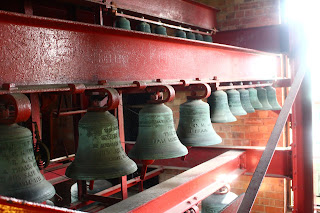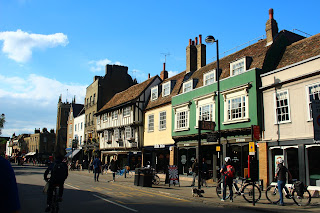Justin told you about the first part of our day in Cambridge (and all of the punting stories) and I'll continue with our journey overland!
We got off of the punt in a bay near the edge of town and noticed a lot of other people enjoying the lovely weather. Believe it or not, this was apparently a slow day on the river! They said on the really busy days, you can basically walk up and down the centre of the river without getting your feet wet.
 |
| Does the kneeboarder know he's giving the kayaker a free ride? |
 |
| We headed over to the field on the right for a picnic lunch. It is obviously a part-time cow pasture so we had to watch where we stepped and sat! |
 |
| Our picnic view |
 |
| More views from the bay |
 |
| The river Cam is crossed by many bridges - this is how Cambridge got its name! |
More Cambridge information! It is a very old town - there's evidence of settlements there that are at least 3,500 years old, and the first town charter was granted in the 1120's. (As Justin said, the university was founded in 1209, so not long afterwards!). Cambridge seems to be very much a university town - most of the services and businesses we saw rely on the students and staff. It's a shame that we couldn't go into the colleges due to exams, but we had a free day and it was sunny, and those two things don't happen often here.
Cambridge has 38 listed churches and chapels, which seems pretty high
for a population of 125,000 (1/5th of whom are students!). Justin spoke a bit about King's College Chapel, but there are many more to see.
 |
| This is St. Botolph's, which was built in the 10th or 11th century. It has a neat North American link - it was named for Botolph, a 7th century abbot and the patron saint of travellers. He also had a town named after him - Botolph's Town, or Boston, Lincolnshire. This is of course where Boston, Mass. gets its name from. |
 |
| Closeup of the clock on St. Botolph's |
|
|
|
 |
| This is St. Bene't's Church (Benedict), and it's the oldest church in the region, built around 1000 AD |
 |
| Each hassock at St. Bene't's looks like it was cross-stitched by hand, and every one in the church was different. The front row were the four main apostles (there's that winged lion again, following us since Venice!) |
 |
| The Round Church (Holy Sepulchre) is one of only four medieval round churches still in use in England. Sadly it was closed for the day by the time we got there. |
 |
| This is the inside of Great St. Mary's, the largest church in Cambridge. It is the official church of Cambridge University, as well as the parish church. It was nice inside, but the rest standout of the tour is climbing the 123 steps to the top of the tower to get a great panorama of the surrounding area |
 |
| Turn around from the altar and head just to your left of the main door to begin your climb. I loved the ceiling in this church! It was built from oak in 1505. You may notice that the church has two organs, which is rare. |
 |
| We passed the bells, which are very famous. Apparently this church has the 2nd oldest bell-ringing society in the world, and they composed the chimes which are now used by Big Ben at Westminster. |
 |
| The bell-ringers can be heard twice on Sunday, calling people to service, and also on Monday evenings when they practice. They ring the bells by pulling on these ropes in the room below. The rest of the time the chimes are automated |
Up at the top, we took the time to get a great view of Cambridge and its skyline! I recently got a circular polarizing filter for my camera to help highlight clouds and the colours of the sky, and I had a fun time trying it out on this trip.
 |
| The buildings above the markets here look just as crooked as those in Amsterdam, especially the dark one between the yellow and white buildings |
Last but not least, churchwise, we visited King's College Chapel for evensong. As Justin pointed out, the acoustics of this building are phenomenal. I'm not religious and had no idea of what was happening during the service, but the atmosphere was pretty incredible. The choir is made up of 30 boys and men, and is world-famous. Wish we could have recorded it! They are so popular that even on a random Sunday, we had to line up about 30 minutes before service started to be guaranteed a seat.
 |
| Outside on the street |
 |
| Passing through the gate |
 |
| The Great Court of King's College, just inside the gate |
 |
| Turn right and join the lineup for evensong |
 |
| Looking back towards the gate |
 |
| Still in line, looking across the court to the last side of the square |
 |
| As we entered, before we had to put away our camera |
The one thing I really wish I could have photographed was the ceiling of this church. It was absolutely stunning. I found out later that King's College has the largest fan vault in the world.
 |
| Photo credit: CrusaderMonk at http://historum.com/general-history/76471-why-europe-s-historical-heritage-so-much-more-impressive-24.html |
 |
| Photo credit: https://en.wikipedia.org/wiki/Fan_vault#/media/File:Kings_college_cambridge_ceiling.jpg |
 |
| Walking back out into the lovely day after service was finished |
 |
| This is the underside of the gate, and I loved all of the nests built by the swallows. You can see them darting in and out of their nests in these pictures. |
 |
| Zoom! |
We were pretty hungry at this point, so we headed over to the Eagle, one of the sprawling, multi-roomed pubs that are so common here. The Eagle is famous for its RAF Bar, where airmen during World War II grafitti'd the ceiling. In addition to maintaining the ceiling, plenty of military types have come here and left service badges and stickers, so the entire place is really interesting to visit.
 |
| Pretty low-key frontage |
 |
| But pretty incredible as you walk inside! |
After that we mostly wandered around the city until cocktail hour, enjoying the sites and doing some geocaching. Here are some more interesting and beautiful sites from our afternoon walk, in no particular order:
 |
| England has an absolute ton of flowering trees, and they all seem to be in bloom this week. It's gorgeous. |
 |
| Tiny car! |
 |
| This candy store really made me think of Honeydukes from Harry Potter |
 |
| They really like decorative wrought iron in this city |
 |
| We finally found a VR (Queen Victoria) mailbox! I've been on the lookout for one since Malta! |
 |
| Someone
told us this is wisteria vine. I think I'm going to spend a lot of
money on our garden when we get home trying to recapture all of the
plant here, and I'm worried that most of it will die because it will
miss that particular British climate (10*C all year round, with daily
rain and patches of sun) |
 |
| Delicious Belgian waffle from the market |
 |
| Hey, we have a Beef Baron in our London, too! |
As we've said, we couldn't tour the colleges as it was exam time. We did get a look at the central courtyard of several colleges (King's College was the most awe-inspiring one), although I couldn't tell you which is which if you paid me. They sure were pretty though!
 |
| Lawn companies must make a killing in Cambridge. My Dad has finally found his people! |
 |
| Each college seemed to be made up of four buildings around a central square that you weren't allowed to walk on, under pain of death |
 |
| This one had a bit more of a garden to it, but also a big lawn |
 |
| Each gatehouse had storage for bikes. As Justin said, most students live in their colleges for their whole time at university, and it's actually cheaper than living off campus. We found out that in Cambridge, there are actual bylaws that undergraduate students must live within a 3 mile radius of Great St. Mary's (the centre of town), and cannot own a car. If you want to live further away you have to apply for an exemption! They say they don't want students' studying disturbed by travel. |
This fascinating thing is the Corpus Clock, which was designed in 2008 for Corpus Christi College. The gold face was formed by explosions in a vaccuum, and it is turned by the locust-like monster (Chronophage) on top. There are no hands, but the blue lights indicate the hours, minutes, and seconds. It was pretty hypnotic! I wish they'd placed it somewhere instead of right on a busy corner, because I'm worried that one day someone's going to get hit by a car looking at this thing!
 |
| The legs turn the clock as the Chronophage marches on endlessly, chewing up time |
 |
| I think the designer of this clock (John C Taylor) and HR Giger would have been good friends |
 |
| For scale |
|
|
If you really like clocks and how they work, there is a great video at the following link, as well as some pictures that aren't struggling with reflections in the glass!
To finish our day, Justin had found a neat hotel rooftop bar to have a few drinks on. We felt pretty underdressed walking into the lobby, as we were greeted by a man in an honest-to-god grey morning coat with tails and top hat, but luckily the dress code on the roof was casual, and the views of the surrounding town and River Cam were great.
As you can see from these last pictures, the weather was starting to turn, but we made it back to the car before the rain started and had a nice drive home.
It's always nice to have a 'lazy day' in the UK. My work hours are crazy (gone for 12 hours a day at best most days, and working every 3rd Saturday), and coupled with our many weekend trips (currently standing at 14 countries since we left Canada!) it can be exhausting. But it's hard to find the middle ground between taking it easy, and knowing we won't have such easy access to all these wonderful locations soon enough. Time is going by really quickly - we're already 8 months into our year abroad, and we recently purchased our tickets home for mid-September (yay!). We'll continue to try and find a healthy balance between wanting to see all of the sights of Europe, and taking time to smell the wisteria vine.
...Oh yeah, and we're going to Berlin next weekend! Stay tuned!















































































